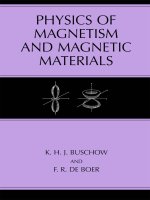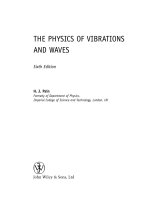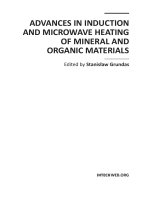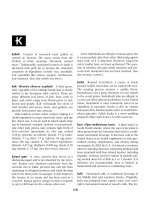- Trang chủ >>
- Khoa Học Tự Nhiên >>
- Vật lý
Physics of magnetism and magnetic materials k buschow, f de boer
Bạn đang xem bản rút gọn của tài liệu. Xem và tải ngay bản đầy đủ của tài liệu tại đây (6.37 MB, 191 trang )
Physics of Magnetism
and Magnetic Materials
This page intentionally left blank
Physics of Magnetism
and Magnetic Materials
K. H. J. Buschow
Van der Waals-Zeeman Instituut
Universiteit van Amsterdam
Amsterdam, The Netherlands
and
F. R. de Boer
Van der Waals-Zeeman Instituut
Universiteit van Amsterdam
Amsterdam, The Netherlands
KLUWER ACADEMIC PUBLISHERS
NEW YORK, BOSTON, DORDRECHT, LONDON, MOSCOW
eBook ISBN: 0-306-48408-0
Print ISBN: 0-306-47421-2
©2004 Kluwer Academic Publishers
New York, Boston, Dordrecht, London, Moscow
Print ©2003 Kluwer Academic/Plenum Publishers
New York
All rights reserved
No part of this eBook may be reproduced or transmitted in any form or by any means, electronic,
mechanical, recording, or otherwise, without written consent from the Publisher
Created in the United States of America
Visit Kluwer Online at:
and Kluwer's eBookstore at:
Contents
Chapter 1. Introduction
1
Chapter 2.
The Origin of Atomic Moments
3
2.1.
Spin and Orbital States of Electrons
3
2.2.
The Vector Model of Atoms
5
Chapter 3. Paramagnetism of Free Ions
11
3.1.
The Brillouin Function
11
3.2.
The Curie Law
13
References
17
Chapter 4. The Magnetically Ordered State
19
4.1.
The Heisenberg Exchange Interaction and the Weiss Field
19
4.2.
Ferromagnetism
22
4.3.
Antiferromagnetism
26
4.4.
Ferrimagnetism
34
References
41
Chapter 5. Crystal Fields
43
5.1.
Introduction
43
5.2.
Quantum-Mechanical Treatment
44
5.3.
Experimental Determination of Crystal-Field Parameters
50
5.4.
The Point-Charge Approximation and Its Limitations
52
5.5.
Crystal-Field-Induced Anisotropy
54
5.6.
A Simplified View of 4f-Electron Anisotropy
56
References
57
Chapter 6. Diamagnetism
59
Reference
61
v
vi
CONTENTS
Chapter 7.
Itinerant-Electron Magnetism
63
7.1.
Introduction
63
7.2.
Susceptibility Enhancement
65
7.3.
Strong and Weak Ferromagnetism
66
7.4.
Intersublattice Coupling in Alloys of Rare Earths and 3d Metals
70
References
73
Chapter 8. Some Basic Concepts and Units
75
References
83
Chapter 9. Measurement Techniques
85
9.1.
The Susceptibility Balance
85
9.2.
The Faraday Method
86
9.3.
The Vibrating-Sample Magnetometer
87
9.4.
The SQUID Magnetometer
89
References
89
Chapter 10.
Caloric Effects in Magnetic Materials
91
10.1.
The Specific-Heat Anomaly
91
10.2.
The Magnetocaloric Effect
93
References
95
Chapter 11. Magnetic Anisotropy
97
References
102
Chapter 12. Permanent Magnets
105
12.1.
Introduction
105
12.2.
Suitability Criteria
106
12.3.
Domains and Domain Walls
109
12.4.
Coercivity Mechanisms
112
12.5.
Magnetic Anisotropy and Exchange Coupling in Permanent-Magnet
Materials Based on Rare-Earth Compounds
115
12.6.
Manufacturing Technologies of Rare-Earth-Based Magnets
119
12.7.
Hard Ferrites
122
12.8.
Alnico Magnets
124
References
128
Chapter 13.
High-Density Recording Materials
131
13.1.
Introduction
131
13.2.
Magneto-Optical Recording Materials
133
13.3.
Materials for High-Density Magnetic Recording
139
References
145
CONTENTS
vii
Chapter 14.
Soft-Magnetic Materials
147
14.1.
Introduction
147
14.2.
Survey of Materials
148
14.3.
The Random-Anisotropy Model
156
14.4.
Dependence of Soft-Magnetic Properties on Grain Size
158
14.5.
Head Materials and Their Applications
159
14.5.1
High-Density Magnetic-Induction Heads
159
14.5.2
Magnetoresistive Heads
161
References
163
Chapter 15.
Invar Alloys
165
References
170
Chapter 16.
Magnetostrictive Materials
171
References
175
Author Index
177
Subject Index
179
This page intentionally left blank
1
Introduction
The first accounts of magnetism date back to the ancient Greeks who also gave magnetism its
name. It derives from Magnesia, a Greek town and province in Asia Minor, the etymological
origin of the word “magnet” meaning “the stone from Magnesia.” This stone consisted of
magnetite and it was known that a piece of iron would become magnetized when
rubbed with it.
More serious efforts to use the power hidden in magnetic materials were made only
much later. For instance, in the 18th century smaller pieces of magnetic materials were
combined into a larger magnet body that was found to have quite a substantial lifting power.
Progress in magnetism was made after Oersted discovered in 1820 that a magnetic field
could be generated with an electric current. Sturgeon successfully used this knowledge
to produce the first electromagnet in 1825. Although many famous scientists tackled the
phenomenon of magnetism from the theoretical side (Gauss, Maxwell, and Faraday) it is
mainly 20th century physicists who must take the credit for giving a proper description of
magnetic materials and for laying the foundations of modem technology. Curie and Weiss
succeeded in clarifying the phenomenon of spontaneous magnetization and its temperature
dependence. The existence of magnetic domains was postulated by Weiss to explain how
a material could be magnetized and nevertheless have a net magnetization of zero. The
properties of the walls of such magnetic domains were studied in detail by Bloch, Landau,
and Néel.
Magnetic materials can be regarded now as being indispensable in modern technology.
They are components of many electromechanical and electronic devices. For instance, an
average home contains more than fifty of such devices of which ten are in a standard
family car. Magnetic materials are also used as components in a wide range of industrial
and medical equipment. Permanent magnet materials are essential in devices for storing
energy in a static magnetic field. Major applications involve the conversion of mechanical to
electrical energy and vice versa, or the exertion of a force on soft ferromagnetic objects. The
applications of magnetic materials in information technology are continuously growing.
In this treatment, a survey will be given of the most common modern magnetic mate-
rials and their applications. The latter comprise not only permanent magnets and invar
alloys but also include vertical and longitudinal magnetic recording media, magneto-optical
recording media, and head materials. Many of the potential readers of this treatise may
have developed considerable skill in handling the often-complex equipment of modern
1
2
CHAPTER 1.
INTRODUCTION
information technology without having any knowledge of the materials used for data stor-
age in these systems and the physical principles behind the writing and the reading of the
data. Special attention is therefore devoted to these subjects.
Although the topic Magnetic Materials is of a highly interdisciplinary nature and com-
bines features of crystal chemistry, metallurgy, and solid state physics, the main emphasis
will be placed here on those fundamental aspects of magnetism of the solid state that form
the basis for the various applications mentioned and from which the most salient of their
properties can be understood.
It will be clear that all these matters cannot be properly treated without a discussion
of some basic features of magnetism. In the first part a brief survey will therefore be given
of the origin of magnetic moments, the most common types of magnetic ordering, and
molecular field theory. Attention will also be paid to crystal field theory since it is a prereq-
uisite for a good understanding of the origin of magnetocrystalline anisotropy in modern
permanent magnet materials. The various magnetic materials, their special properties, and
the concomitant applications will then be treated in the second part.
2
The Origin of Atomic Moments
2.1. SPIN AND ORBITAL STATES OF ELECTRONS
In the following, it is assumed that the reader has some elementary knowledge of quantum
mechanics. In this section, the vector model of magnetic atoms will be briefly reviewed
which may serve as reference for the more detailed description of the magnetic behavior of
localized moment systems described further on. Our main interest in the vector model of
magnetic atoms entails the spin states and orbital states of free atoms, their coupling, and
the ultimate total moment of the atoms.
The elementary quantum-mechanical treatment of atoms by means of the Schrödinger
equation has led to information on the energy levels that can be occupied by the electrons.
The states are characterized by four quantum numbers:
1.
The total or principal quantum number n with values 1,2,3, determines the size
of the orbit and defines its energy. This latter energy pertains to one electron traveling
about the nucleus as in a hydrogen atom. In case more than one electron is present, the
energy of the orbit becomes slightly modified through interactions with other electrons,
as will be discussed later. Electrons in orbits with n = 1, 2, 3, … are referred to as
occupying K, L, M, shells, respectively.
2.
The number
l
can take one of the integral
values 0, 1, 2, 3, , n – 1 depending on the shape of the orbit. The electrons with
l = 1, 2, 3, 4, …
are referred to as s, p, d, f, g,…electrons, respectively. For
example, the M shell (n = 3) can accommodate s, p, and d electrons.
l
l
,
The orbital angular momentum quantum number describes the angular momentum
of the orbital motion. For a given value of the angular momentum of an electron
due to its orbital motion equals
3.
The magnetic quantum number describes the component of the orbital angular
momentum
l
along a particular direction. In most cases, this so-called quantization
direction is chosen along that of an applied field. Also, the quantum numbers
can take exclusively integral values. For a given value of l, one has the following
possibilities: For instance, for a d electron the
permissible values of the angular momentum along a field direction are
and
Therefore, on the basis of the vector model of the atom, the plane of the
electronic orbit can adopt only certain possible orientations. In other words, the atom
is spatially quantized. This is illustrated by means of Fig. 2.1.1.
3
4
CHAPTER 2.
THE ORIGIN OF ATOMIC MOMENTS
4.
The spin quantum number describes the component of the electron spin
s
along
a particular direction, usually the direction of the applied field. The electron spin s
is the intrinsic angular momentum corresponding with the rotation (or spinning) of
each electron about an internal axis. The allowed values of
are and the
corresponding components of the spin angular momentum are
According to Pauli’s principle (used on p. 10) it is not possible for two electrons to occupy
the same state, that is, the states of two electrons are characterized by different sets of the
quantum numbers
and
The maximum number of electrons occupying a given
shell is therefore
The moving electron can basically be considered as a current flowing in a wire that coin-
cides with the electron orbit. The corresponding magnetic effects can then be derived by
considering the equivalent magnetic shell. An electron with an orbital angular momentum
has an associated magnetic moment
where is called the Bohr magneton. The absolute value of the magnetic moment is
given by
and its projection along the direction of the applied field is
The situation is different for the spin angular momentum. In this case, the associated
magnetic moment is
5
SECTION 2.2.
THE VECTOR MODEL OF ATOMS
where is the spectroscopic splitting factor (or the
g
-factor for the
free electron). The component in the field direction is
The energy of a magnetic moment in a magnetic field is given by the Hamiltonian
where is the flux density or the magnetic induction and is the
vacuum permeability. The lowest energy
the ground-state energy,
i
s reached for
and
parallel. Using Eq. (2.1.6) and one finds for one single electron
For an electron with spin quantum number
the energy equals
This corresponds to an antiparallel alignment of the magnetic spin moment with respect to
the field.
In the absence of a magnetic field, the two states characterized by
degenerate, that is, they have the same energy. Application of a magnetic field lifts this
degeneracy, as illustrated in Fig. 2.1.2. It is good to realize that the magnetic field need not
necessarily be an external field. It can also be a field produced by the orbital motion of the
electron (Ampère’s law, see also the beginning of Chapter 8). The field is then proportional
are
proportional to
to the orbital angular momentum l and, using Eqs. (2.1.5) and (2.1.7), the energies are
In this case, the degeneracy is said to be lifted by the spin–orbit
interaction.
2.2. THE VECTOR MODEL OF ATOMS
When describing the atomic origin of magnetism, one has to consider orbital and
spin motions of the electrons and the interaction between them. The total orbital angular
momentum of a given atom is defined as
where the summation extends over all electrons. Here, one has to bear in mind that the
summation over a complete shell is zero, the only contributions coming from incomplete
6
CHAPTER 2. THE ORIGIN OF ATOMIC MOMENTS
shells. The same arguments apply to the total spin angular momentum, defined as
The resultants and
interaction to form the resultant total angular momentum
thus formed are rather loosely coupled through the spin–orbit
This type of coupling is referred to as Russell–Saunders coupling and it has been proved to
be applicable to most magnetic atoms, J can assume values ranging from J = (L – S), (L –
S + 1), to (L + S – 1), (L + S). Such a group of levels is called a multiplet. The level lowest
in energy is called the ground-state multiplet level. The splitting into the different kinds
of multiplet levels occurs because the angular momenta
and interact with each other
· is the spin–orbit coupling
constant). Owing to this interaction, the vectors
via the spin–orbit interaction with interaction energy
causes them to precess around the constant vector
and exert a torque on each other which
This leads to a situation as shown in
Fig. 2.2.1, where the dipole moments and corresponding to
the orbital and spin momentum, also precess around
It is important to realize that the
total momentum
is not collinear with
but is tilted toward the spin owing
makes an
angle
with The precession frequency is usually quite high
so that only the component of
and also precesses around
to its larger gyromagnetic ratio. It may be seen in Fig. 2.2.1 that the vector
along is observed, while the other component averages
out to zero. The magnetic properties are therefore determined by the quantity
7
SECTION 2.2. THE VECTOR MODEL OF ATOMS
It can be shown that
This factor is called the Landé spectroscopic
g
-factor
For a given atom, one usually knows the number of electrons residing in an incomplete
electron shell, the latter being specified by its quantum numbers. We then may use Hund’s
rules to predict the values of L
,
S
,
and J for the free atom in its ground state. Hund’s
rules are:
(1)
The value of
S
takes its maximum as far as allowed by the exclusion principle.
(2)
The value of L also takes its maximum as far as allowed by rule (1).
(3)
If the shell is less than half full, the ground-state multiplet level has J = L – S, but
if the shell is more than half full the ground-state multiplet level has J = L + S.
The most convenient way to apply Hund’s rules is as follows. First, one constructs the level
scheme associated with the quantum number l. This leads to 2l + 1 levels, as shown for
f electrons (l = 3) in Fig. 2.2.2. Next, these levels are filled with the electrons, keeping
the spins of the electrons parallel as far as possible (rule 1) and then filling the consecutive
lowest levels first (rule 2). If one considers an atom having more than 2l + 1 electrons in
shell l, the application of rule 1 implies that first all 2l + 1 levels are filled with electrons
with parallel spins before the remainder of electrons with opposite spins are accommodated
in the lowest, already partly occupied, levels. Two examples of 4f-electron systems are
shown in Fig. 2.2.2. The value of L is obtained from inspection of the
values of the
occupied levels whereas S is equal to
The J values
are then obtained from rule 3.
Most of the lanthanide elements have an incompletely filled 4f shell. It can be easily
verified that the application of Hund’s rules leads to the ground states as listed in Table 2.2.1.
The variation of L and
S
across the lanthanide series is illustrated also in Fig. 2.2.3.
The same method can be used to find the ground-state multiplet level of the 3d ions in
the iron-group salts. In this case, it is the incomplete 3d shell, which is gradually filled up.
8
CHAPTER 2.
THE ORIGIN OF ATOMIC MOMENTS
As
seen in Tables 2.2.1 and 2.2.2, the maximum
S
value is reached in each case when the
shells are half filled (five 3d electrons or seven 4f electrons).
In most cases, the energy separation between the ground-state multiplet level and
the other levels of the same multiplet are large compared to kT. For describing the mag-
netic properties of the ions at 0 K, it is therefore sufficient to consider only the ground
9
SECTION 2.2. THE VECTOR MODEL OF ATOMS
level characterized by the angular momentum quantum number
J
listed in Tables 2.2.1
and 2.2.2.
tum
For completeness it is mentioned here that the components of the total angular momen-
along a particular direction are described by the magnetic quantum number In
most cases, the quantization direction is chosen along the direction of the field. For practical
number associated with the total angular momentum
reason, we will drop the subscript J and write simply m to indicate the magnetic quantum
This page intentionally left blank
3
Paramagnetism
of Free Ions
3.1. THE BRILLOUIN FUNCTION
Once we have applied the vector model and Hund’s rules to find the quantum numbers J
,
L
,
and S of the ground-state multiplet of a given type of atom, we can describe the magnetic
properties of a system of such atoms solely on the basis of these quantum numbers and the
number of atoms N contained in the system considered.
If the quantization axis is chosen in the z-direction the z-component m of J for each
atom may adopt 2J + 1 values ranging from m = – J to m = + J. If we apply a magnetic
field H (in the positive z-direction), these 2J + 1 levels are no longer degenerate, the
corresponding energies being given by
where is the atomic moment and its component along the direction of
the applied field
(which we have chosen as quantization direction). The constant
is
equal to
The lifting of the (2J + 1)-fold degeneracy of the ground-state manifold by the magnetic
field is illustrated in Fig. 3.1.1 for the case Important features of this level scheme
are that the levels are at equal distances from each other and that the overall splitting is
proportional to the field strength.
Most of the magnetic properties of different types of materials depend on how this
level scheme is occupied under various experimental circumstances. At zero temperature,
the situation is comparatively simple because for any of the N participating atoms only the
lowest level will be occupied. In this case, one obtains for the magnetization of the system
However, at finite temperatures, higher lying levels will become occupied. The extent to
which this happens depends on the temperature but also on the energy separation between
the ground-state level and the excited levels, that is, on the field strength.
The relative population of the levels at a given temperature T and a given field strength
H can be determined by assuming a Boltzmann distribution for which the probability
of
11
12
CHAPTER 3. PARAMAGNETISM OF FREE IONS
M
finding an atom in a state with energy is given by
The magnetization of the system can then be found from the statistical average
of the magnetic moment This statistical average is obtained by weighing
the magnetic moment of each state by the probability that this state is occupied and
summing over all states:
The calculation of the magnetization by means of this formula is a cumbersome procedure
and eventually leads to Eq. (3.1.10). For the readers who are interested in how this result
has been reached and in the approximations made, a simple derivation is given below. Since
there is no magnetism but merely algebra involved in this derivation, the average reader will
not lose much when jumping directly to Eq. (3.1.10), keeping in mind that the magnetization
given by Eq. (3.1.10) is a result of the thermal averaging in Eq. (3.1.4), involving 2J +1
equidistant energy levels.
By substituting into Eq. (3.1.4), and using the relations
i
n
and
one may write
Since there cannot be any confusion with
here, we have dropped the subscript J of
and simply write
g
from now on.
From the standard expression for the sum of a geometric series, one finds
13
SECTION 3.2. THE CURIE LAW
Substitution of this result into Eq. (3.1.5) leads to
Since sinh one obtains
After carrying out the differentiation, one finds
with
with
the so-called Brillouin function, given by
It is good to bear in mind that in this expression H is the field responsible for the level
splitting of the 2J + 1
ground-state manifold. In most cases, H is the externally applied
magnetic field. We shall see, however, in one of the following chapters that in some materials
also internal fields are present which may cause the level splitting of the (2
J
+ 1)-mainfold.
Expression (3.1.9) makes it possible to calculate the magnetization for a system of
N atoms with quantum number
J
at various combinations of applied field and temperature.
Experimental results for the magnetization of several paramagnetic complex salts
containing and ions measured in various field strengths at low temper-
atures are shown in Fig. 3.1.2. The curves through the data points have been calculated
by means of Eq. (3.1.9). There is good agreement between the calculations and the
experimental data.
3.2. THE CURIE LAW
Expression (3.1.9) becomes much simpler in cases where the temperature is higher and
the field strength lower than for most of the data shown in Fig. 3.1.2. In order to see this, we
will assume that we wish to study the magnetization at room temperature of a complex salt
of in an external field
which corresponds to an external flux density
more details about units will be discussed
14
CHAPTER 3. PARAMAGNETISM OF FREE IONS
in Chapter 8). For
one has J = 9/2 and g = 8/11 (see Table 2.2.1). Furthermore,
we make use of the following values
and
At room temperature (298 K), one derives for y in Eq. (3.1.11):
Since we now have shown that under the above conditions, it is justified to use only
the first term of the series expansion of
for small values of y
From this follows, keeping only the first term,
15
SECTION 3.2. THE CURIE LAW
The magnetic susceptibility is defined as Using Eq. (3.2.2), we derive for the
magnetic susceptibility
with the Curie constant C given by
Relationship (3.2.3) is known as the Curie’s law because it was first discovered experi-
mentally by Curie in 1895. Curie’s law states that if the reciprocal values of the magnetic
susceptibility, measured at various temperatures, are plotted versus the corresponding tem-
peratures,
one finds a
straight line passing through
the
origin. From
the
slope
of
this
line
one finds a value for the Curie constant C and hence a value for the effective moment
The Curie behavior may be illustrated by means of results of measurements made on the
intermetallic compound
shown in Fig. 3.2.1.
It is seen that the reciprocal susceptibility is linear over almost the whole temperature
range. From the slope of this line one derives per Tm atom, which is close
to the value expected on the basis of Eq. (3.2.5) with
J
and
g
determined by Hund’s rules
(values listed in Table 2.2.1). Similar experiments made on most of the other types of rare-
earth tri-aluminides also lead to effective moments that agree closely with the values derived
with Eq. (3.2.5). This may be seen from Fig. 2.2.3 where the upper full line represents the
variation of
across the rare-earth series and where the effective moments
experimentally observed for the tri-aluminides are given as full circles. In all these cases,
one has a situation basically the same as that shown in the inset of Fig. 3.2.1 for
where the ground-state multiplet level lies much lower than the first excited multiplet level.
In these cases, one needs to take into account only the 2
J
+ 1 levels of the ground-state
multiplet, as we did when calculating the statistical average by means of Eq. (3.1.4). Note
that in the temperature range considered in Fig. 3.2.1, the first excited level J = 4 will
practically not be populated.
The situation is different, however, for and It is shown in the inset of
Fig. 3.2.1 that for
several excited multiplet levels occur which are not far from the
ground state. Each of these levels will be split by the applied magnetic field into 2J + 1
sublevels. At very low temperatures, only the 2
J
+ 1 levels of the ground-state multiplet
are populated. With increasing temperature, however, the sublevels of the excited states
also become populated. Since these levels have not been considered in the derivation of
Eq. (3.2.3) via Eq. (3.1.4), one may expect that Eq. (3.2.3) does not provide the right
answer here. With increasing temperature, there would have been an increasing contribu-
tion of the sublevels of the excited states to the statistical average if we had included these
levels in the summation in Eq. (3.1.4). Since, for
the excited multiplet levels have
higher magnetic moments than the ground state, one expects that M and will increase with
increasing temperature for sufficiently high temperatures. This means that
will decrease
with increasing temperature, which is a strong violation of the Curie law (Eq. 3.2.3). Exper-
imental results for demonstrating this exceptional behavior are shown in Fig. 3.2.1.
16
CHAPTER 3. PARAMAGNETISM OF FREE IONS
The magnetic splitting of the ground-state multiplet level (J = L – S = 5 –5/2 = 5/2)
and the first excited multiplet level (
J
=
L – S
+ 1 = 5 – 5/2 + 1 = 7/2) is illustrated in
Fig. 3.2.2. Note that the equidistant character is lost not only due to the energy gap between
the
J
= 5/2 and
J
= 7/2 levels but also due to a difference in energy separation between
the levels of the J = 5/2 manifold (g = 2/7 and the levels of the J = 7/2 manifold
(g = 52/63).
Generally speaking, it may be stated that the Curie law as expressed in
Eq. (3.2.3), is a consequence of the fact that the thermal average calculated in Eq. (3.1.4)
involves only the 2
J
+ 1 equally spaced levels (see Fig. 3.1.1) originating from the effect of
the applied field on one multiplet level. Deviations from Curie behavior may be expected
whenever more than these 2
J
+ 1 levels are involved (as for
and
or when these
levels are no longer equally spaced. The latter situation occurs when electrostatic fields in
the solid, the crystal fields, come into play. It will be shown later how crystal fields can also
lift the degeneracy of the 2
J
+ 1 ground-state manifold. The combined action of crystal
fields and magnetic fields generally leads to a splitting of this manifold in which the 2J + 1









